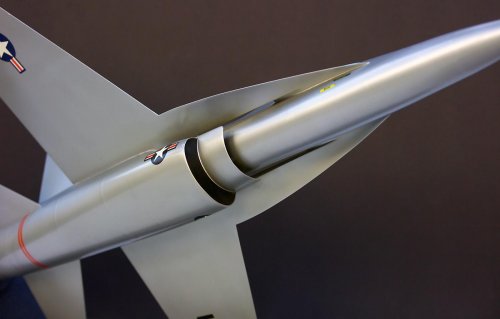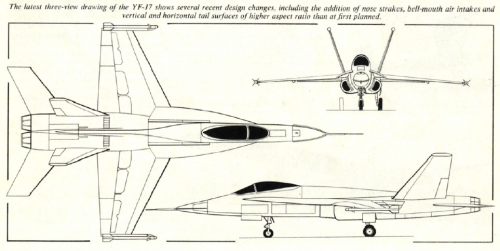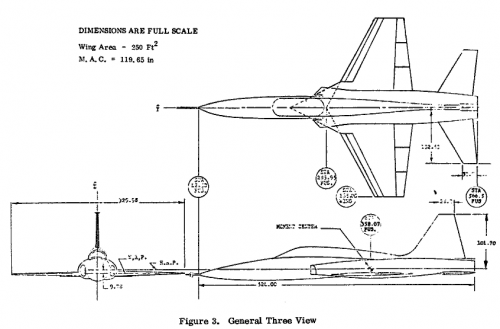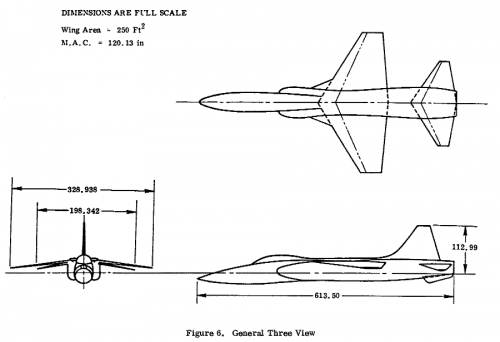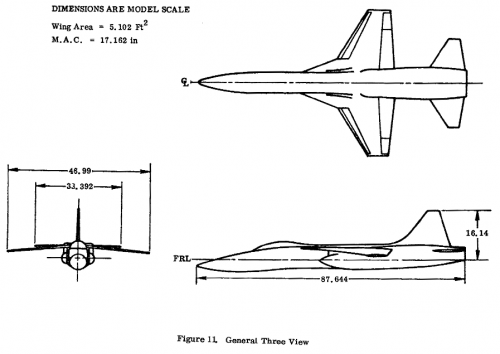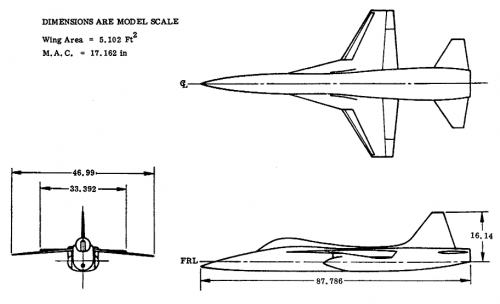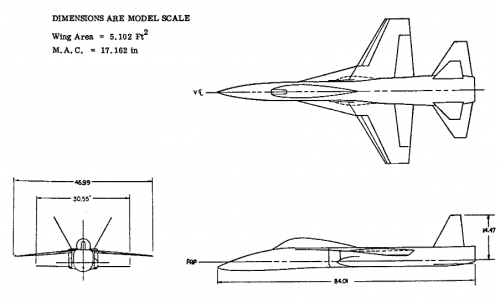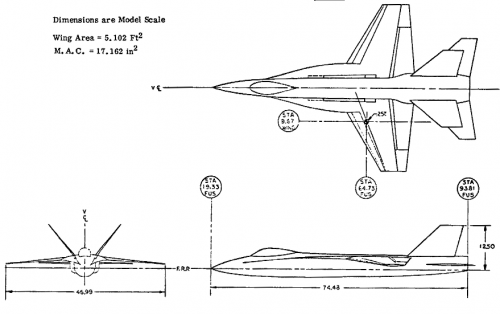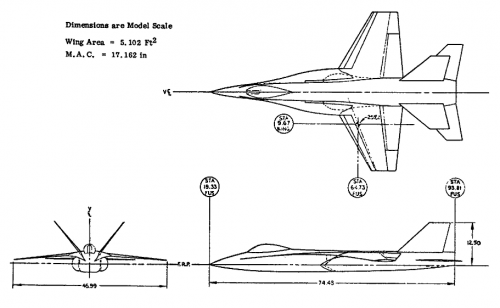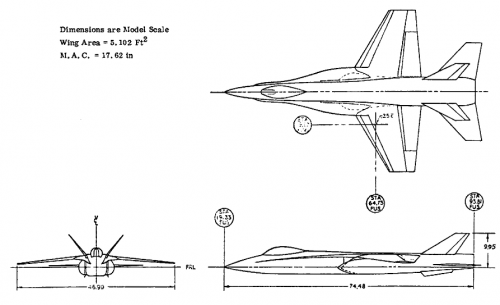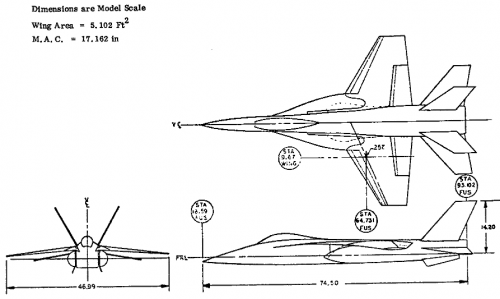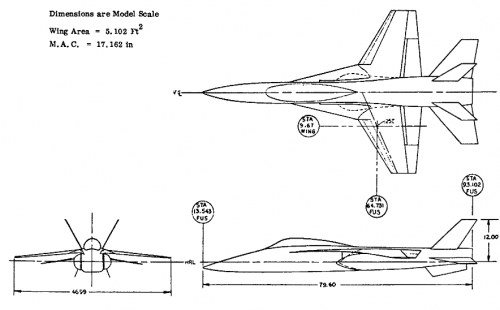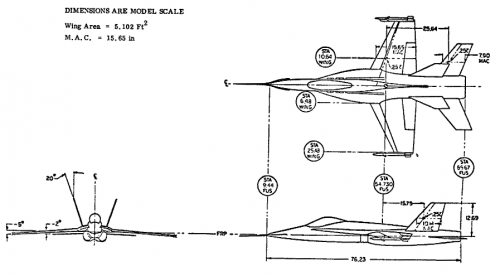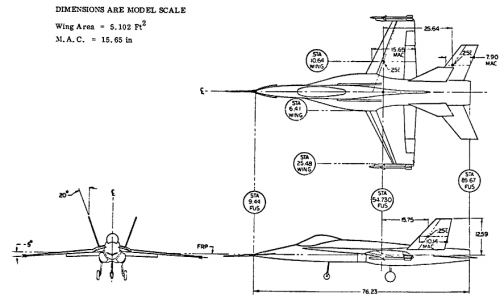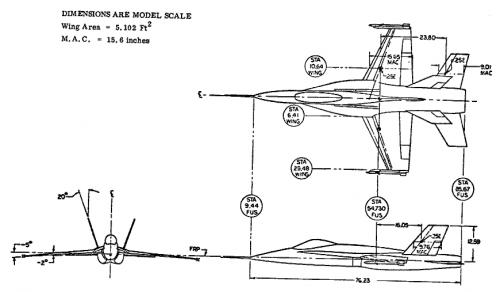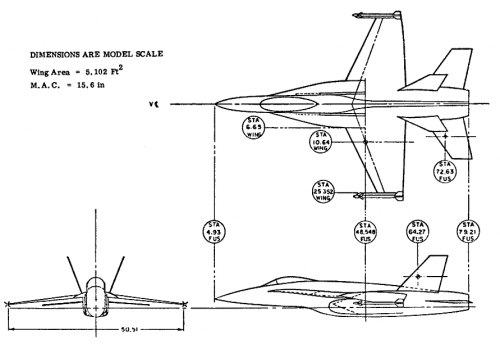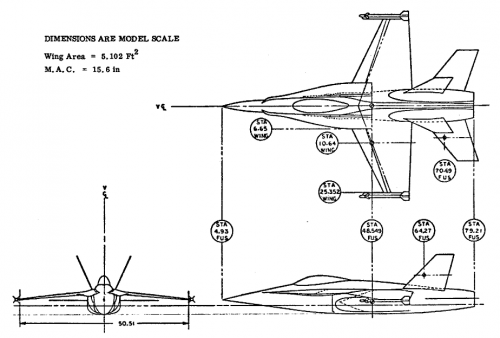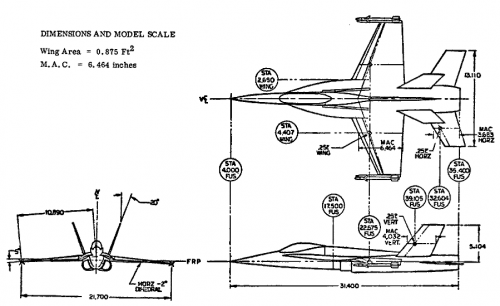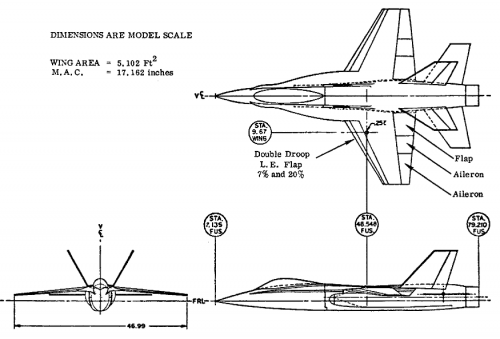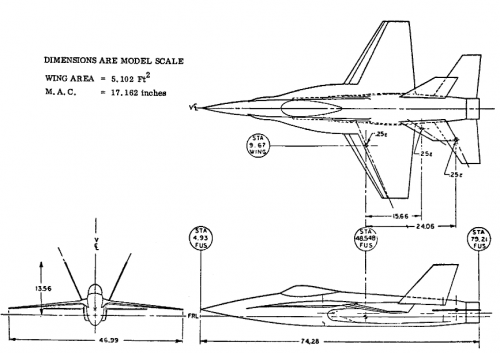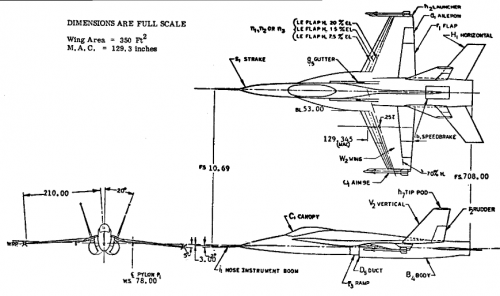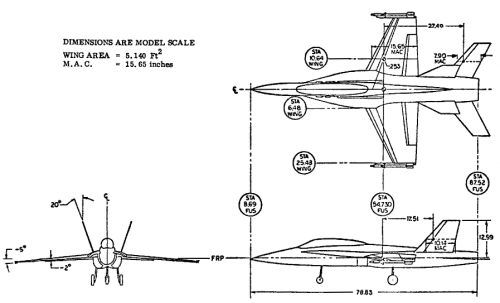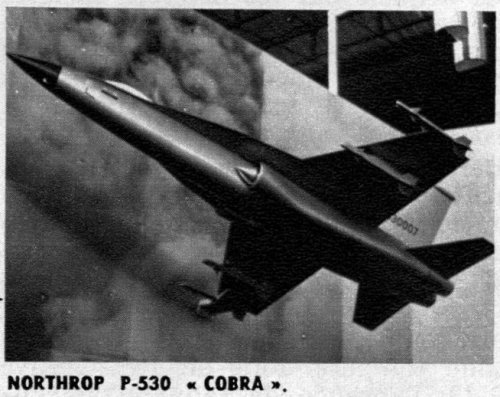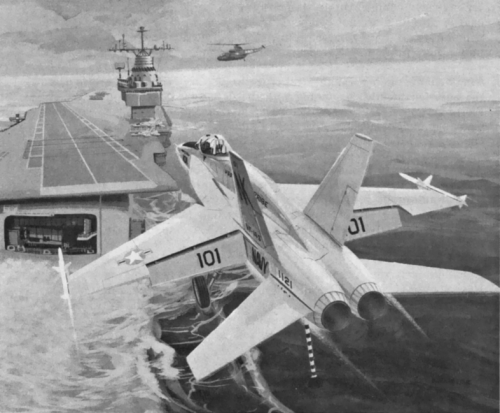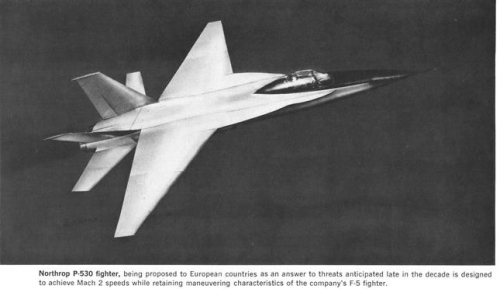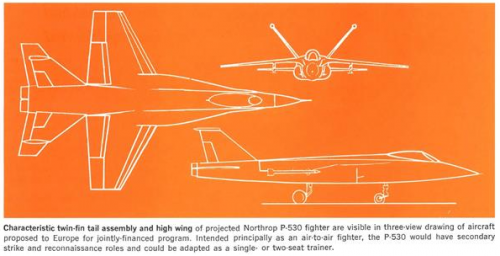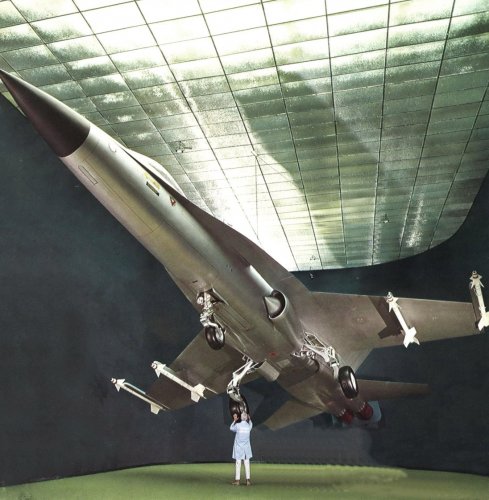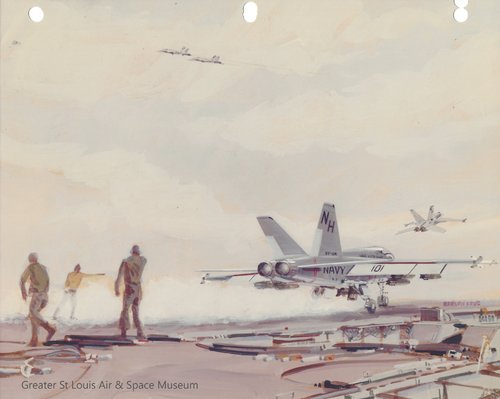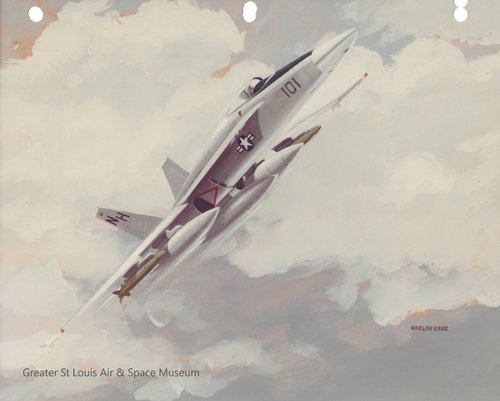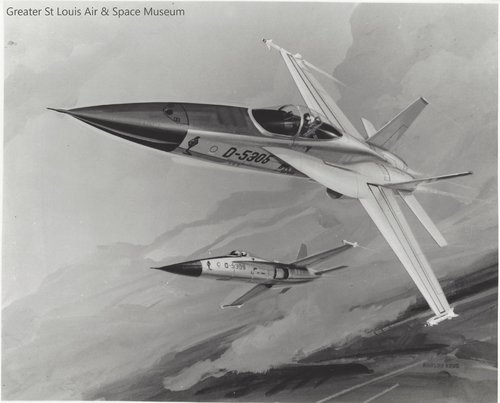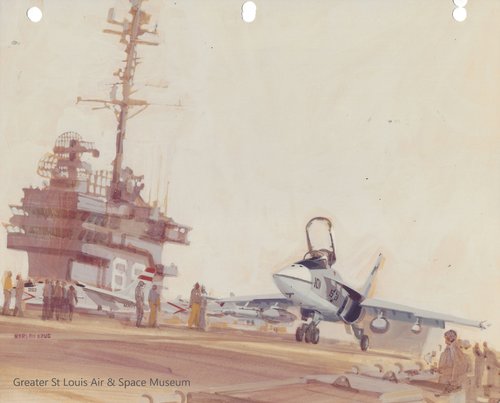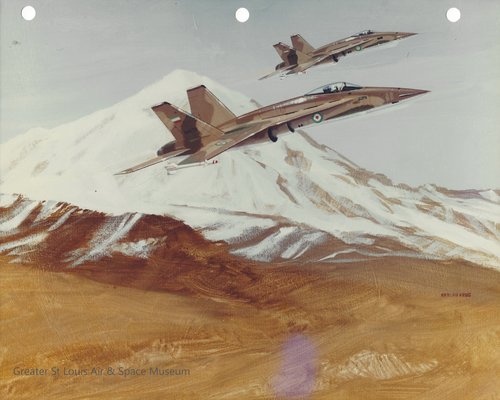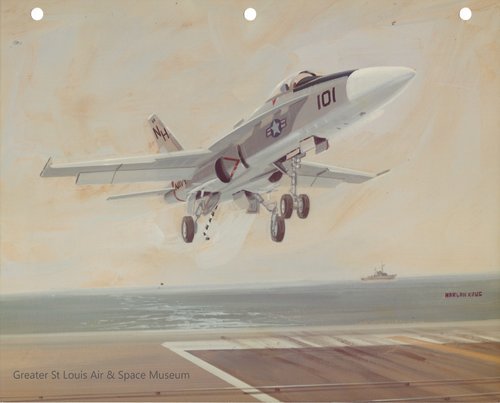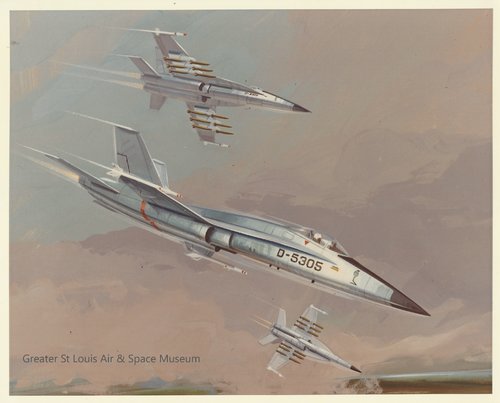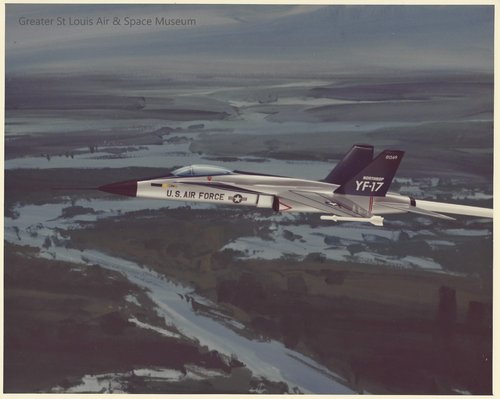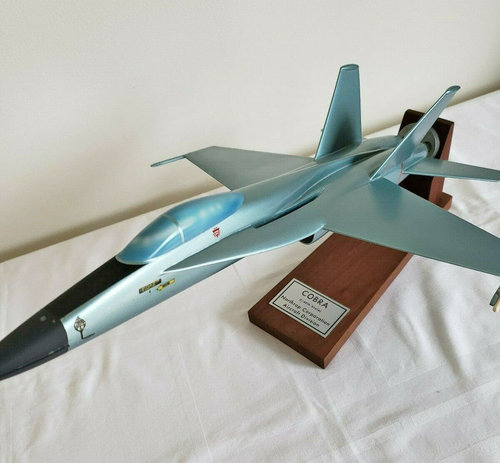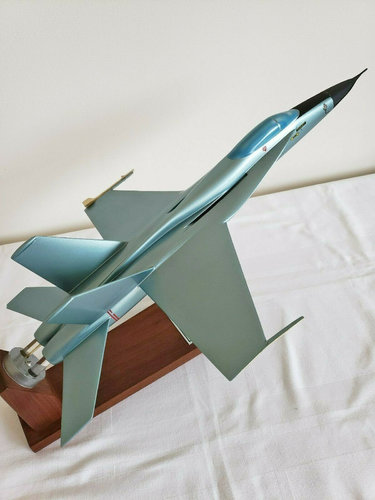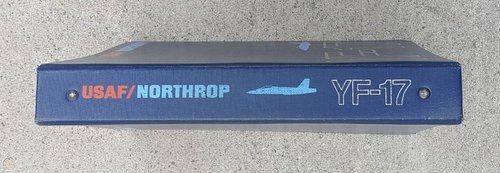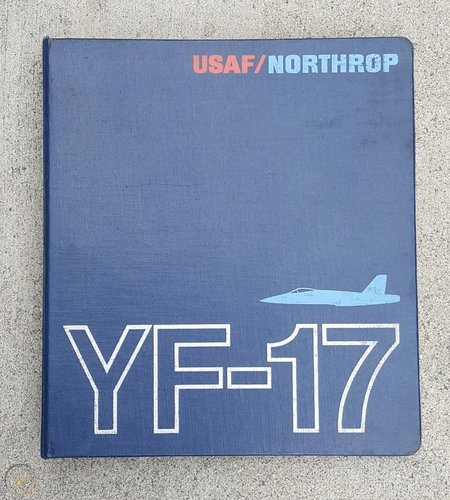You are using an out of date browser. It may not display this or other websites correctly.
You should upgrade or use an alternative browser.
You should upgrade or use an alternative browser.
Northrop P-530 / P-600 / P-610 / YF-17 Design Evolution
- Thread starter Pioneer
- Start date
- Joined
- 31 May 2009
- Messages
- 1,154
- Reaction score
- 677
Steve Pace said:The sculptured boundary layer control orifice above the ventral engine air inlet is most interesting. _SP
... and rather elaborate. There is a complex path of channeled air streams in that area, from the LERX slots to the deep BL splitter plate, all of which need to stay docile at changing AOAs. Somebody had fun in the wind tunnel with that one.
The bottom view almost conceals the intricacy of this intake.
Attachments
- Joined
- 21 May 2006
- Messages
- 3,002
- Reaction score
- 2,281
Thanks once again Circle-5
This latest photo of the Factory model Northrop P-610's intake is very interesting!
Can I ask an out of the blue question to the forum please?
Can someone maybe take a guestimate as to how much difference in empty weight this F100-engines P-610 version may have differed to the actual two-engine arrangement P-600/F-17 that was preceded with might have been??
For I'm curious as to how much difference there might have been with the thrust-to-weight ratio with the P-610 and the General Dynamics Model 401 (YF-16)
Regards
Pioneer
This latest photo of the Factory model Northrop P-610's intake is very interesting!
Can I ask an out of the blue question to the forum please?
Can someone maybe take a guestimate as to how much difference in empty weight this F100-engines P-610 version may have differed to the actual two-engine arrangement P-600/F-17 that was preceded with might have been??
For I'm curious as to how much difference there might have been with the thrust-to-weight ratio with the P-610 and the General Dynamics Model 401 (YF-16)
Regards
Pioneer
Last edited:
- Joined
- 27 December 2005
- Messages
- 17,752
- Reaction score
- 26,438
Sundog said:
Cobra and the Lightweight Fighter
By THE TECHNICAL EDITOR
'Flight" photographs by TOM HAMILL
ONE OF THE MOST INTRIGUING EXHIBITS at the Paris Air Show was the full-scale mock-up of the Northrop P-530 Cobra. The Cobra is Northrop's effort to establish a high-technology, low-risk co-operative venture with countries which, while industrially and strategically ambitious, do not wish to become involved with the investment needed for programmes such as Jaguar or MRCA. The original design, finalised about two years ago, was aimed at the Dutch Starflghter replacement market, and since then it has been on the short-lists of Norway and Australia. While these countries have been pursuing their naturally protracted deliberations, Northrop has continued to refine the Cobra, and the model on show at Paris displayed a number of differences from previous representations of this fighter. The company has put 900,000 engineering man-hours and 5,000hr of wind-tunnel testing into the project over the past seven years, while the General Electric J101 turbojet has three years of testing under US Government contracts behind it.
The P-530 design is now largely underpinned by the US Air Force, which in May last year awarded a $39 million contract to Northrop to build two LWF (Lightweight Fighter) technology demonstrators. construction is now well under way and the first of the pair is due to fly in April next year at Edwards AFB, California. The results of the YF-17 programme will in large measure be complementary to those obtained from two General Dynamics Model 401s, designated YF-16, which comprise the other LWF programme.
With the spur of a definite contract for the YF-17 the design has been improved by spending a further 500,000 man-hours of engineering effort and 5,000hr of wind-tunnel and simulator work. The metallic blue Cobra exhibit brought to the Paris Air Show from California last May is a completely new mock-up for engineering development and customer demonstration. It was constructed using 100 actual engineering drawings and was completed early this year. The real aeroplane is reproduced in great detail, with a fully representative, ejection-seat-equipped cockpit, and twin mock-up engines by GE. The structure is built in subassemblies for carriage by air to prospective customers.
The Cobra and the YF-17 have the same external shape, but the similarities in many places are not even skin-deep! The P-530 is designed for the air-superiority role, broadened to take in ground attack to suit international needs for a multi-purpose, lightweight fighter. This is in line with company thinking that the best fighter-bomber is that obtained by adding ground-attack requirements to a primarily air-superiority performance. The YF-17, on the other hand, is totally dedicated to air superiority and has no secondary role. The purpose of the 12-month, 300hr-plus LWF flight programme is to demonstrate the highest performance obtainable in this role with current or reasonably accessible technology. The USAF has no plans at present for an operational aeroplane of this type, so Northrop and GD are not competing against one another tor follow-on production contracts.
So different are the Cobra and the YF-17 that Northrop has allocated separate teams to their development in its Advanced Fighter Group at Hawthorne, California. Each works independently of the other and there is crossfertilisation only at the programme management level. Lee Begin heads the Cobra effort, while Walt E. Fellers leads the YF-17. But it is fair to say that the LWF will take the Cobra out of the paper stage to verify the aerodynamics, handling and much of the structural work, and put it firmly on the road to sales.
Quite extraordinary efforts have been made to save weight in the LWF design, because structural efficiency is the key to this type of aeroplane. Northrop is understandably reluctant to spell out the YF-17 secrets in detail, but there are clearly several areas in which appreciable savings can be made. For example, rigorous supervision of the avionics installation can save more weight than might be thought from a survey of the black boxes. Lee Begin told Flight that, as a rule of thumb, a lb increase in avionics weight per se implies a total airborne penalty of 5lb on the clean take-off weight of the aircraft. This comes
about as a result of increases in cabling involved, more cooling air (hence a bigger air-conditioning system), sturdier structure to carry the increased load, greater engine power and extra fuel to restore the performance required. More weight means more money, and another rule of thumb at Northrop is to cost current-technology avionics at $1,000/lb. Individual systems vary quite widely, of course, from $800/lb to about $1,500/lb, but, says Begin, the rule-of-thumb figure is a quite reliable guide taken over the whole installation.
Take-off weights
The Lightweight Fighter has very narrowly specified equipment for air superiority, and it is largely the extra avionics which will expand the performance into that of the multi-mission Cobra. The YF-17 will have a typical take-off weight of 21,0001b, but the max TOW of the Cobra increases to nearly 40,0001b as a result of its extra equipment, fuel and external warload. Both LWF and Cobra have conventional flight-control systems with stability augmentation, though they can be flown, even in combat, without the latter.
Lee Begin also told Flight that the two fighters will be structurally somewhat different. The Mach 2 Cobra will have a mainly aluminium structure, but the YF-17 will contain a number of graphite-composite assemblies, weighing about 1,000lb in total. The relatively small budget will not allow extensive use of composites, owing to the high cost of tooling, but it should be sufficient to demonstrate the weight savings—up to 30 per cent—possible with this material.
The Cobra and YF-17 will both be powered by two General Electric YJ101-GE-100 single-shaft turbojets, which are stated to have a thrust in the 15,000lb class with afterburning. The J101 is tailored to the Cobra and is based on the scaled-down core engine, or gas generator, of the same company's 30,000lb-thrust F101-GE-100 turbofan engine being developed for the Rockwell B-1A variable geometry
bomber. The Preliminary Flight Rating Test is planned for this autumn. The reason for choosing a turbojet (actually a very small quantity of bypass air is bled to provide cooling) over a turbofan is the need to maintain the thrust/weight to high altitude. This quite simple engine has a ten-stage compressor, an annular combustor and is driven by two compressor stages. Its pressure ratio is greater than 20:1.
High thrust/weight ratio
The LWF will have a thrust/weight figure probably exceeding that of any other aircraft, including the Harrier and the F-15. On the basis of information given earlier, it could be a breath-taking 1-5-1-6 by the time some fuel has burned off and the target is engaged. Specific excess power is the key to air combat. High installed dry thrust also enables the fully loaded fighter to be flown to the target at a sufficiently high altitude to allow the power setting for best fuel consumption to coincide with conditions for cruise at the maximum lift/drag ratio. When this happens the aeroplane is operating at its greatest efficiency, travelling the furthest possible distance for every pound of fuel burned. This situation is, of course, the basis of commercial and military this class of combat aircraft because the thrust of the
older types was usually insufficient to allow them to be flown at best-range altitude. Walt Fellers told Flight that, while the aeroplane can cruise on one engine, Northrop studies have shown that it is actually more efficient (in terms of specific range, i.e. distance flown per pound of fuel consumed) to fly with both running.
The very unusual shape of the Cobra and its TJSAF counterpart is a result of the demands for extreme manoeuvrability. This calls for the ability to fly at high load factors, sometimes at quite low speed, while retaining very precise control. This in turn implies operating the wing efficiently at large angles of attack, with the least possible flow breakdown over the wing and tail surfaces. A large, lightly loaded, virtually straight wing is more efficient for this purpose than a swept or delta design. Begin told Flight that wing sweep in excess of 30° in this type of aeroplane imposes unacceptable penalties on the manoeuvrability needed for air combat. The solution adopted by Northrop—which must be regarded as a significant advance in aerodynamic development—is to integrate the 320 sq ft, 60lb/sq ft-70lb/sq ft wing and fuselage forebody profiles by means of a low-aspect-ratio fairing. GD's YF-16 is based on similar thinking. In straight and level flight, or in moderate manoeuvres, the strake contributes little to the performance. But at the large angles of attack associated with high-g combat the strake substantially alters the flow field over the aeroplane. Its sharply swept leading edge generates a vortex (or rather two vortices, one on each side of the forward fuselage). When this flows over the top of the wing it creates an area of low pressure and, consequently, lift. Also it prevents an undesirable span-wise migration of the boundary layer on the upper surface. The 4 per cent thick wing, with its sharp leading-edge profile, would readily stall without this vortex. The slender-delta strakes, with the fore-body immersed in them, also contribute substantially to the total lift, the more so as the angle of attack increases.
Delta wing effect
The strakes have another function. They protect the engine intakes from the large angles of attack which they would experience if, for example, they were situated in the nose. This induced flow effect is, of course, a deltawing characteristic In this way the airflow distortion at the compressor face is minimised, even under the most unfavourable conditions. The situation is helped by the characteristics of the powerplant which, as a turbojet, is less susceptible than a fan engine to disturbances. The strake is a development of the vestigial fairing used on the F-5E for the same purpose. At the junction of the wing and fuselage there is a thin, chordwise slot, the purpose of which is to bleed off some of the low-energy boundary-layer air which would otherwise be sucked into the engines. In normal flight the sphtter plates, ahead of the intake, and this slot swallow about equal quantities of air, but as the angle of attack increases a much larger proportion of the boundary layer leaks through it.
Leading-edge and trailing-edge flaps are manually selected for take-off and landing, but operate automatically for combat, via an angle-of-attack signal from the air-data computer. They increase the CLmax to nearly 2 when depressed. This technique stems from the system used in the F-5E and the Dutch and Canadian F-5s. Stability and controllability come from the use of very large vertical and horizontal surfaces. Blanketing of the fins and rudders by the rest of the airframe in some manoeuvres is very difficult to avoid. By canting them outwards, one of the two fins is certain to be immersed in "clean air," even under adverse conditions. It is noticeable that these surfaces have not been put at the extreme end of the fuselage, where they would exert the maximum stabilising moment. Instead they begin very early on the area-ruled fuselage, so that they are better able to "look over the top of the wing" in combat manoeuvres.
Pilot's vision
The provision of a goo4 field of view for the pilot is important in this type of aeroplane. The clear bubble canopy, with no reinforcing frames forward of the sliding canopy leading edge, allows virtually unobstructed vision in almost every direction. It is noteworthy that the benefits of bubble canopies are being rediscovered. They become de rigeur for fighters at a late stage in the Second World War when visibility, particularly at medium and high FLIGHT International, 23 August 1973 Close-up of the Hughes Atlas radar, with nosecone pulled forward for access to the antenna and mechanical scanning system. Perhaps the most important technological development in this equipment is the use of LSI (large-scale integration) techniques, whereby no fewer than 20 million components can be packaged into one cubic foot of the radar volume, by comparison with three million units in the F-14 and seven million components in the F-15. The radar works at X-band frequencies, with a peak power of 3.56kW altitude, was accounted more important than their slight extra drag over those of the faired canopies. Spitfires, Mustangs and Thunderbolts all "went bubble" and the trend carried over to the F-80 and F-86 before losing momentum in such designs as the F-100, F-102 and F-105. A new design of headrest in the Cobra and YF-17 enables the pilot to take advantage of this potential visibility by allowing greatly increased head movement. The ability to carry out sustained high-g manoeuvres increasingly shows up the pilot's physiology as the weak link in the man/machine combination and his relative lack of resistance to blackouts, the draining of blood from the head to the feet, is now a big factor. In the Lightweight Fighter the pilot sits in a semi-reclining attitude, which increases his tolerance to high g levels.
Fire-control radar
The fire-control radar for the Cobra will be chosen from competitive designs by Westinghouse, Hughes and Autonetics. Northrop has specified four radar modes: target ranging (air to ground), dogfight, air target detection (look up) and ground or air target detection (look down). The performance sought by Northrop includes a target price of $200,000 and a maximum weight of 2001b. Both the Hughes Atlas and the Westinghouse WX-160 radars proposed use planar-array, mechanically scanned aerials. Both are packaged in easily replaceable modules. The system proposed by Hughes (which has the best track record of the three companies—F-86, F-89, F-94, F-101, F-102, F-106, YF-12, F-14 and F-15) is a simplified radar based on F-15 equipment. Using a wide beam in the look-up mode, it can detect targets with a 5m2 silhouette at a range of 30 miles, increasing to 39 miles on selection of narrow beam. When switched to look down, it can pick up 5m2 targets at a range of 16 miles in ground clutter.
- Joined
- 27 December 2005
- Messages
- 17,752
- Reaction score
- 26,438
AFFD-TR-78-94 Analysis of Wind Tunnel Data Pertaining to High Angle of Attack Aerodynamics
http://contrails.iit.edu/DigitalCollection/1978/AFFDLTR78-094volume02.pdf
This report has summaries of dozens of wind tunnel tests in the N300/P530/P600/P610/P630 series.
The following are drawings of wind tunnel models with the dates of the tests.
N300
http://contrails.iit.edu/DigitalCollection/1978/AFFDLTR78-094volume02.pdf
This report has summaries of dozens of wind tunnel tests in the N300/P530/P600/P610/P630 series.
The following are drawings of wind tunnel models with the dates of the tests.
N300
Attachments
- Joined
- 27 December 2005
- Messages
- 17,752
- Reaction score
- 26,438
- Joined
- 27 December 2005
- Messages
- 17,752
- Reaction score
- 26,438
- Joined
- 27 December 2005
- Messages
- 17,752
- Reaction score
- 26,438
- Joined
- 27 December 2005
- Messages
- 17,752
- Reaction score
- 26,438
Published on Sep 5, 2015
Ed Levy conducts a walk-around of the Northrop YF-17 Cobra prototype fighter and highlights design features. Produced by Jarel & Betty Wheaton for Peninsula Seniors www.pvseniors.org
Ed Levy conducts a walk-around of the Northrop YF-17 Cobra prototype fighter and highlights design features. Produced by Jarel & Betty Wheaton for Peninsula Seniors www.pvseniors.org
YF-17 prototype with Bob Sandusky
Published on Oct 28, 2014
Bob's first seven years were spent at Boeing where he participated in the aerodynamic and configuration design of Boeing’s entry to the Light Weight Fighter competition. He was with Northrop for 22 years, starting with aerodynamic and performance analysis of the YF-17 prototype. He then progressed to be Manager of Advanced Design and followed that to be Chief Engineer of the Advanced Tactical Fighter Program throughout the ten years of the program.
Published on Oct 28, 2014
Bob's first seven years were spent at Boeing where he participated in the aerodynamic and configuration design of Boeing’s entry to the Light Weight Fighter competition. He was with Northrop for 22 years, starting with aerodynamic and performance analysis of the YF-17 prototype. He then progressed to be Manager of Advanced Design and followed that to be Chief Engineer of the Advanced Tactical Fighter Program throughout the ten years of the program.
Test Pilot, Bob Ettinger, talks about the YF 17 and YF-16
Published on Sep 6, 2014
Test Pilot, Bob Ettinger, talks about his time with the Light Weight Fighter, Joint Test Force, flying the Northrop YF-17 and General Dynamics YF-16.
Published on Sep 6, 2014
Test Pilot, Bob Ettinger, talks about his time with the Light Weight Fighter, Joint Test Force, flying the Northrop YF-17 and General Dynamics YF-16.
- Joined
- 3 June 2011
- Messages
- 18,340
- Reaction score
- 12,245
- Joined
- 2 August 2006
- Messages
- 3,256
- Reaction score
- 1,529
It was cool to see Jack Northrop at the roll out. I love videos like this, mainly for flight sim reasons. If I ever model a YF-17, I now have a reference for the gear retraction rates and sequence. I also didn't realize just how sleek the YF-17 looked in flight, as compared to the F/A-18, which I know has a deeper fuselage. But those flying sequences were quite nice. Hopefully, they'll release similar footage of it maneuvering or giving a demo flight.
- Joined
- 25 June 2009
- Messages
- 14,754
- Reaction score
- 6,155
Sundog said:I also didn't realize just how sleek the YF-17 looked in flight, as compared to the F/A-18, which I know has a deeper fuselage.
I saw the F-17 fly and it was a real beauty. I loved it as much as I later hated the F-18, supposedly its production version but a much less appealing aircraft altogether.
- Joined
- 1 April 2006
- Messages
- 11,397
- Reaction score
- 10,314
Last edited by a moderator:
- Joined
- 27 December 2005
- Messages
- 17,752
- Reaction score
- 26,438
- Joined
- 27 December 2005
- Messages
- 17,752
- Reaction score
- 26,438
- Joined
- 27 December 2005
- Messages
- 17,752
- Reaction score
- 26,438
hesham said:Hi,
http://archive.aviationweek.com/image/spread/19710201/11/2
Here's the text.
Aviation Week & Space Technology. February 1, 1971[caption] Northrop P-530 fighter, being proposed to European countries as an answer to threats anticipated late in the decade is designed to achieve Mach 2 speeds while retaining maneuvering characteristics of the company's F-5 fighter.
Northrop Seeks Aid Abroad for Fighter
By Barry Miller
Los Angeles—Northrop Corp. is pursuing a vigorous but low-keyed sales campaign abroad to enlist foreign financing for development of its twin-engine Mach 2 P-530, a versatile air-to-air fighter capable of handling aerial threats during the 1975-85 time period, with secondary capabilities for close support, interdiction, intercept and reconnaissance.
The basic airframe and system design are intended to be adaptable for special applications, such as all-weather interception, reconnaissance or training either in single- or two-place, tandem seating arrangements. Flyaway cost is projected at approximately $2 million each.
By using two engines of substantially greater thrust than in the F-5 family of aircraft and a lightly loaded wing, Northrop designers appear to have designed a vehicle of greater speed and acceleration than the F-5 with the latter’s good maneuvering qualities.
Northrop’s P-530 strategy reportedly revolves around the company’s attempt to get four European countries to supply financing in return for assigning detailed design and licensing production abroad. Because of the magnitude of the cost of such a program, estimated by industry to be on the order of $350-$400 million for the non-recurring expense excluding engine development, any European group of four countries probably would have to include West Germany.
The American company has been conducting engineering design and manufacturing studies on the P-530 since the summer of 1966 (AW&ST Aug. 7, 1967, p. 26). Considerably larger than the F-5, the P-530 is readily distinguished by a large, four-surface empennage with conventional low horizontal stabilizer with no dihedral and dual dorsal fins canted out about 45 deg. from the vertical. By contrast to the F-5, the P-530 has a high wing with swept leading edge similar to that of its predecessor but without the noticeable fuselage fairing.
Its 400 sq. ft. of wing area, which account for the low wing loading figure of 60 lb./sq. ft., is more than double the F-5 wing area. The area rule fuselage is faired from a point near the cockpit back to the wings. Overall wingspan is roughly 33 ft, and aircraft length is about 51 ft.
The proposed aircraft would be powered by a pair of General Electric turbojets with afterburners derived from the J97 engine in the Teledyne Ryan Aeronautical 154 high-altitude reconnaissance drone (AW&ST Nov. 9, 1970, p. 46). Advanced versions of this engine could generate as much as 12,000 to 14,000 lb. of thrust each, significantly more than the engine in the Ryan drone application. Northrop also is believed to be suggesting the Pratt & Whitney F-100 engines slated for the McDonnell Douglas F-15 air superiority fighter.
The P-530’s takeoff weight without any external stores and with 7,200 lb. of internal fuel is 25,000 lb. Thrust-to-weight ratio for that weight and an anticipated total of at least 20,000 lb. thrust is 0.80. The ratio rises to 0.94 at a combat weight of 21,400 lb. with expenditure of half of the internally carried fuel load.
An internal pallet-mounted cannon plus air-to-air missiles provide armament for the aircraft’s primary fighter role. Its seven store positions, three on each wing and one on the belly centerline, can accommodate bombs, rockets, missiles or fuel tanks. The maximum external load is roughly 12,000 1b., with maximum design weights of 3,000 lb. on the belly station, 1,100 lb. on the two outboard points and 2,000 lb. at the four inboard stores positions on the wings.
Avionics Options
Several avionics options are being offered, including forward-looking radar, probably in X-band, essential for all-weather operations and radar-guided missiles. There is capacity for about 900 lb. of avionic equipment.
In its clean takeoff, 25,000-lb. configuration, the P-530 requires about 800 ft. for a takeoff ground run. With 50% of its internal fuel expended, the aircraft can climb from sea level at a rate of about 44,000 ft./min. and reach a maximum speed of Mach 2. Its ceiling at Mach 0.9 is 60,000 ft.
For a typical air-to-air mission, the aircraft, armed with four missiles and equipped with external fuel tanks, would weigh about 35,000 lb. at takeoff and require about 1,800 ft. of runway. It would have a 350-naut. mi. radius for a high-low-low-high mission profile with half the distance to and from the combat scene traveled at speeds of Mach 0.8 at sea level. In combat at 15,000 ft. altitudes, the P-530 using afterburners would be able to complete 10 turns maneuvering at Mach 0.8 in a period of 4.5 min.
For a sample air-to—ground mission, the aircraft, loaded with external fuel tanks and 3,000 lb. of stores, would require 2,100 ft. for a takeoff, given its mission takeoff weight in excess of 37,000 lb. Following a high-low-low-high mission profile and retaining its fuel tanks, the aircraft could operate out to a 350 naut. mi. radius.
On return, a P-530 would approach a landing strip at 107 kt. with a design landing sink speed of 10 ft./sec. Its landing roll would be about 1,400 ft. The aircraft’s flight design gross weight with four air-to-air missiles would be 26,150 lb. in subsonic flight with full fuel load and 23,350 lb. in supersonic flight with 60% fuel load.
Maximum design gross weight is in excess of 38,000 lb., and landing design gross weight is about 25,000 lb.
Payload radius of the P-530 stretches from about 150 naut. mi. for a 7,500 lb. load of 750 lb. bombs to over 200 naut. ml. for 6,000 lb., and nearly 300 naut. mi. for 4,500 lb. on a typical high-low-low-high mission.
Turn Rates
In sustained maneuvering flight, the P-530 is designed for high turn rates by comparison with typical competitive aircraft. At 15,000 ft., its turn rate is as high as 13 deg/sec. at Mach 0.8 when it is not carrying external loads and has 50% of its internal fuel. From speeds of Mach 0.4 to Mach 1, the aircraft can turn at rates at least as high as 10 deg./sec.
In similar circumstances at 30,000 ft., the P-530 can turn at a rate as high as 8 deg/sec. at Mach 0.8 speeds and at least 5 deg/sec. at any speed between Mach 0.4 and Mach 1.1.
For ferry missions, the aircraft can be fitted with wing tip fuel tanks in addition to a 400-gal. center-line tank and two 600-gal. inboard pylon tanks to increase range to 2,600 naut. mi. The wing tip tanks stretch the wingspan to about 48 ft. In this configuration the aircraft requires 1,900 ft. for a takeoff ground roll.
A special two-seat reconnaissance version of the P-530 proposed by Northrop would enable the aircraft to perform photographic and side-looking radar missions. In a typical sensor load, the P-530 would have panoramic and high—altitude cameras in its nose; forward- looking low-altitude and right and left-hand oblique cameras under the first pilot’s seat and a side-looking radar under the second man’s position. The side-looking radar recorder and radio frequency equipment would be housed in the avionics compartment, behind the second pilot.
Heavy emphasis is being placed on the P-530, as it was in the F-5 program, on low maintenance costs and ease of maintainability. The anticipated total maintenance index, or man-hr. per flight hr., is 29.6. This comprises 6.5 man-hr./flight hr. on the flight line, 3.2 scheduled, 8.8 unscheduled on the aircraft and 11.1 field maintenance. Direct maintenance men per aircraft is 9.7, while wing manning requirement exclusive of pilots is in excess of 1,000 personnel
Operating Costs
The total maintenance and operating cost per flight hr. is estimated to be $535, compared with $321 for the F-5. This includes $164 for depot cost, $102 for base material cost. $165 for base labor cost and $104 for fuel, oil and lubricants.
The aircraft will have zero-zero ejection seats, air refueling and tail hook provisions. Northrop is calling the P-530 the Cobra and has already prepared decals for the new name.
[caption] Characteristic twin-fin tail assembly and high wing of projected Northrop P-530 fighter are visible in three-view drawing of aircraft proposed to Europe for jointly-financed program. Intended principally as an air-to-air fighter, the P630 would have secondary strike and reconnaissance roles and could be adapted as a single- or two~seat trainer.
- Joined
- 27 December 2005
- Messages
- 17,752
- Reaction score
- 26,438
European Interest Sought For Northrop
London—Northrop Corp. has mounted a strong drive to interest European air forces and companies in a technological and work-sharing program involving the Northrop 530 advanced tactical fighter project. The project, which gained impetus when the French government canceled its participation in the Anglo-French variable-geometry fighter program (AW&ST July 10, p. 32), is aimed at a 1970s low-cost requirement to replace Northrop F-5s, Lockheed F-104Gs and Fiat G-91s in the conventional attack role.
A technical and marketing team from Northrop. headed by C. R. Gates. vice president-international, last week concluded first-phase talks with air staffs and manufacturers in Great Britain, Italy, Germany. Holland and Belgium. Gates said the talks were exploratory, first to determine air staff interest in the Northrop 530, and secondly to discuss technological sharing on the basis first established by the company president, Thomas V. Jones. at the Paris air show (AW&ST June 5. p. 24).
Jones’ idea is that U.S. technical know-how is a resource that can be shifted across boundaries. In any case, Northrop is not interested in control of a European company to further a single project.
European manufacturers were first consulted on the project about a year ago at a meeting at Northrop headquarters in Beverly Hills, Calif. Since then, the Northrop 530 has taken shape as a conventional twin-engine fighter, aimed at operational and maintenance simplicity.
Northrop. which now has the 530 project in advanced wind-tunnel testing, is aiming at a fly-away price of about $1.5 million. Powerplants would be two General Electric GE1 series engines. now funded to dry running but with the possibility of further funding for afterburner development. The actual engine probably will bethe GE1-J1A powerplant of the 7,000lb. thrust class, which has a maximum diameter of 24 in. and is approximately 140 in. long. An engine from the same family, the GE1-10, has been selected for the US/FRG U.S.-German advanced V/STOL, and the 11A version for a still-secret U.S. Air Force project.
The Northrop 530, which is a company-funded project, will have a maximum weapons payload in excess of 10,000 lb., without carrying external fuel and operating from hard-surfaced runways. The design concept, however, calls for a wide variety of roles and considerable leeway in installation of sophisticated avionics. The aircraft also will operate in the “battlefield arena” concept of quick strikes and return for quick turnaround.
The Northrop team primarily was exploring European mission requirements in the early 1970s as part of a plan to refine the project further. There is no U.S. requirement at present.
In the broad view, under the Jones plan of technological sharing, the company is prepared to buy into European concerns, but only up to 40% ownership, or enter into license and sharing agreements with European countries having large participation in initial design work.
There is a possibility of Northrop establishing a British base in addition to the firm‘s present 25% holding in Royal Netherlands Aircraft Factories-Fokker. which, in turn, has holdings in Belgium.
The situation in Britain, in which Rolls-Royce and Vickers alone hold 60% of British Aircraft Corp.. remains clouded, in that government-sponsored efforts to merge BAC and aviation interests of the Hawker Siddeley Group have met with little success so far.
Aviation Week & Space Technology August 7 1967
- Joined
- 27 December 2005
- Messages
- 17,752
- Reaction score
- 26,438
Aviation Week a Space Technology. April 23, 1973<caption> Latest configuration of Northrop Corp.’s P-530 Cobra multi-role tactical fighter is shown in this full-scale wooden mockup fitted with four Philco—Ford AIM-9J Sidewinder air-to—air missiles. P-530 design has nose strakes to smooth airflow to extended leading edges of each wing. Cobra fuselage has been extensively area ruled aft of the cockpit. and the forward section has been raised in relation to the wing. Engine inlets and fuselage underside also have been refined and airflow control slots in leading edge extensions enlarged. Design has provision for a center fuselage stores station and one more hardpoint under inboard portion of each wing. <caption>
Cobra Keyed to Foreign Participation
Northrop fighter program would be cooperative international effort; company pushing for initial Australian, Dutch orders By Donald E. Fink
Hawthorne, Calif—Northrop Corp. is moving to solidify its P-530 Cobra multi-role tactical fighter development program around potential initial orders for 200 aircraft from Australian and Dutch governments. The P-530, which Northrop plans to develop under an international industrial participation concept, is designed to meet the needs of the air forces in countries participating in the program. A worldwide market for 1,000 aircraft is forecast by Northrop through the late 1980s, with no sales projected to the U. S. Air Force.
Both the Australian and Dutch governments are in the final phases of aircraft evaluations with their respective air forces, each of which has a requirement for an advanced multi-role fighter for the 1980s. In addition to the need for new fighters, both countries are anxious to expand their small aircraft industries. And Northrop officials are striving to convince them that the P-530 program will meet the operational requirements of the Royal Australian Air Force and the Royal Netherlands
Air Force as well as provide a development and manufacturing capability essential to the future growth of their national aircraft industries.
In Australia and The Netherlands Northrop faces competition from the export version of the Super Mirage F-1,nwhich Avions Marcel Dassault-Breguet Aviation is offering with support from the French government, and a multi-role version of the Saab AJ37 Viggen from Sweden. Saab and Dassault also are offering industrial offset incentives to the Australians and Dutch, but they are not as extensive as the P-530 joint development and production plan, Northrop says.
Final air force re-equipment decisions are expected in the two countries by September. If the P-530 is selected, the RAAF is expected to opt for an initial batch of 100 aircraft and the RNAF 75. The Dutch have a long-range requirement for up to 200 aircraft, but their most immediate need is for about 100 aircraft to replace the RNAF’s fleet of Lockheed F-104G Starfighters.
P-530 officials expect the selections made by the Australians and Dutch to influence re-equipment decisions pending in other countries, such as Norway, Belgium, Italy, Greece, Turkey and Iran. These countries have been briefed on the Cobra program and have shown an interest in either joining the cooperative effort or purchasing aircraft from the international consortium, they said.
The current Cobra program goal is to have a final go-ahead decision no later than January. 1974. according to L. F. Begin, manager of the P-530 program office. The initial orders from the Australians and Dutch would not be sufficient to launch the P-530 development program- the minimum is closer to 400 aircraft- but they would be enough to convince other prospective customer countries that the program is viable, Begin said. “We are offering a phased program in which all partners would participate in a pre-production effort at Northrop and build two prototypes,” he said. “This phase would involve three main tasks; building asingle place prototype, a two-place prototype and settling details of our production program working relationships.”
Northrop would take final responsibility for the P-530. Northrop’s basic philosophy of retaining strong central leadership over team efforts in which it is involved would be retained in the Cobra program, he said. But Northrop would not dominate the program to the extent of “ramming decisions down the throats of its partners.” he said.
On the premise that Australia and The Netherlands will be the key partners in the P-530 program, Northrop has established a detailed development and production plan based on potential sales of 1,000 aircraft. Initial agreements covering P-530 orders would be signed by Northrop and the governments of participating countries. Northrop then would negotiate subcontracts with government-designated industrial groups in each country.
Value of the subcontracts would be in proportion to the number of aircraft ordered—a country ordering 100 aircraft would get 10% of the development and production work based on the projected goal of 1,000 aircraft sales.
Once subcontract agreements covering all portions of the aircraft have been signed, teams of 20-25 engineers and technicians from each industrial partner would be brought together at Northrop. Composition of the international team would follow the pattern of any pre-production program, and specialists in different disciplines -design, analysis, tooling, production and finally flight test - would be rotated through Northrop. A few key team members from each industrial partner would stay through the full two-year pre-production period.
The first prototype - a single-seat version - would fly 24 months after go-ahead, Begin said. The aircraft would be equipped with a fully integrated avionics system, including fire control radar, inertial navigation system and headup display, and would be used for systems as well as handling qualities and structural flight tests.
The second prototype - a two-place trainer version - would be completed as soon as possible for use in the initial flight test program and as a demonstration aircraft to other potential customers. The two-place aircraft would be used for load and flutter tests and handling evaluations with weapons and other external stores. Begin said.
Once the two prototypes are flying, the industrial partners would complete the details of the production phase of the program and conduct a joint engineering design effort to refine the production configuration based on flight test data from the prototypes.
The first six production aircraft would be used with the two prototypes to complete Category 1 contractor flight tests and Category 2 flight evaluations for the participating air forces.
First production aircraft—a two-place avionics flight testbed - would fly 24 months after the first prototype. The second production aircraft would be fitted with the internal nose-mounted General Electric M-61 20-mm. cannon and used primarily for fire control system evaluations. Aircraft 5-7 would be used for flying qualities and systems tests and aircraft No. 8 would be the climatic test specimen. The main flight test program would be conducted at the Edwards AFB, Calif, Flight Research Center by a joint flight test team of pilots from all the participating countries.
Begin said the Cobra program also would benefit from the Northrop YF-17A lightweight fighter prototypes, which are scheduled to start flight tests in May, 1974, as a prelude to a flyoff competition with the YF-16A prototypes from General Dynamics Corp.’s Convair Aerospace Div. The YF-17A is essentially identical externally to the twin-engine P-530 and is powered by two General Electric YJ101-GE-100 engines. Powerplants selected for the Cobra are the General Electric GE15/J1A5—a derivative of the YJ101 engine in the same 15,000-lb.-thrust class.
The YF-l6A will have a minimum of systems and no integral fire control unit in keeping with the USAF requirement for a stripped-down airframe for a minimum cost prototype flyoff program. But the 20 months of flight tests with the YF-17A prior to the first flight of the No. 1 P-530 prototype will yield airframe performance data that will benefit the Cobra program, Begin said.
For the production phase of the program, the aircraft will be divided into production packages, and each partner will be awarded subcontracts to supply a portion of the airframe and systems for the total production program. The current plan calls for establishing three final assembly lines—one in Australia, one in The Netherlands and one at Northrop’s main facility here. The tooling will be designed for a maximum rate of 20 aircraft per month, although the rate will be started at five per month and increased gradually to the maximum as the program gathers momentum. At the maximum rate, the assembly lines in Australia and The Netherlands would each produce 2.5 aircraft per month and the Northrop line 15 per month. Production rates at the first two could be increased to cover sales to other countries in their areas.
Establishing production lines in three widely separated locations poses some logistics problems in the transportation of subassemblies, Begin said. But a small fleet of Lockheed L-100-30 Super Hercules cargo transports and some truck or rail transport units for use in Europe would meet the needs of the program. Details of the air cargo links required to supply the three assembly lines up to the maximum rate of 20 aircraft per month have been worked out with the assistance of Saturn Airways. Begin said.
The program plan leaves open the option of subcontracting the subassembly airlift to a cargo carrier such as Saturn, establishing a special Cobra program cargo fleet giving the job to a national carrier from one of the participating countries. The P-530 production packages have been sized to permit economical transport in a Super Hercules type cargo aircraft as well as to divide the aircraft into sections of varying manufacturing value.
A “stuffed concept” will be followed by the subcontractors, which means each subassembly will be brought to the highest possible state of completion, Begin said. All systems, equipment and fittings will be installed in each section, and final assembly will involve little more than fitting the subassemblies together and verifyingthat all systems are functioning.
The production sharing plan includes:
* Northrop—Forward fuselage, including the cockpit, major avionics packages, the “hooded” wing leading edge extension that prompted naming the aircraft the Cobra and final assembly.
* The Netherlands—Center fuselage section and related avionics packages and final assembly.
* Australia - Aft fuselage section - not including the horizontal stabilizer and twin vertical fins—some avionics packages and final assembly.
* Northrop or a third partner country - Wing package, including all control surfaces.
* Northrop or a fourth partner country Empennage package, including all four tail units, control surfaces and actuators.
* Norway or Iran—Drop tanks, pylons, weapons launchers and some avionics packages.
General Electric Co.—GE15/J1A5 engines with the Australian aircraft industry supplying parts and subassemblies. The percentage of U. S.-supplied equipment will be relatively high in the first batch of production aircraft, Begin said. As production progresses, each partner will be free to find local suppliers for the systems and elements needed to equip its aircraft sections. Much of this equipment will be of U. S. design, produced under license, he said.
A worldwide logistics pipeline similar to the one USAF uses to supply the Northrop F-S Freedom Fighter program will be established for the P-530, Begin said. At first, the main supply base will be established at Northrop. Later it would be shifted to Europe and a branch depot would be set up in Australia. All partners would produce spares on a quantity basis for the single support system, which would reduce the cost of spares and insure a constant supply, Begin said.
The Cobra program will be independent of the foreign military sales agreements Northrop has with USAF for the F-5A/B Freedom Fighter and F-5E International Fighter, he said. Cobra program partners probably will form support and maintenance consortiums similar to those major European airlines have established for their wide-body commercial jet transports. An attempt also will be made to agree on a single standardized version of the Cobra, again following the pattern set in the European commercial transport consortiums. “We intend to make every effort to have a standard cockpit and standard avionics packages,” Begin said. “However, it will be possible to add systems and equipment or make changes which do not interfere with the standard configuration.”
An average price—to be determined once major partners are in with initial orders - will be set for the P-530 standard version. Unit price of the aircraft, including research and development costs and the costs of the multi-national production program, currently is set at about $4 million. Any partner wanting a version involving major changes would have to pay for the new research and development required and also reimburse the other partners for any added learning curve costs the new version would generate in the overall manufacturing and assembly program.
There is considerable flexibility in the basic design, Begin said. In addition to its air-superiority, intercept and ground attack capability, the aircraft can be adapted for photo reconnaissance by installing a camera/sensor pack in the nose M-61 cannon compartment or mounting reconnaissance pods on fuselage centerline or underwing stores stations.
The P-530 program is a technology sharing effort that could contribute significantly to reversing the unfavorable U. S. balance-of—payments situation. according to Begin. On a conservative basis, he estimates the program could bring $4 billion in revenue into the country if the 1,000 aircraft sales goal is achieved.
Begin added that the Cobra program will not contribute to the outflow of U. S. technology recently criticized by some members of Congress. Northrop developed the advanced technology used on the aircraft in an independent research program, he said. Cobra partner countries will have access to this technology as it applies to the P-530. but participation in the program does not necessarily mean they will be able to develop similar or more advanced technology on their own.
P-530 Cobra Design Refined
Hawthorne, Calif.—Design of the P-530 Cobra multi-role tactical tighter has been extensively refined by Northrop Corp. during the past 18 months while Australia and The Netherlands, key countries in the international consortium needed to develop the aircraft, have continued to weigh re-equipment decisions for their air forces.
Major changes have been made in the Cobra fuselage - including liberal application of area rule techniques and raising the forward fuselage section in relation to the extended wing leading edge—and the wing profile has been refined in an extensive wind tunnel test series. Placement, shape and size of the inlets for the two General Electric GE15/J1A5 engines also has been changed and the ducts have been faired into the lower fuselage with more sophisticated aerodynamic lines.
The “hooded" wing leading edge extensions, which reach forward beyond the main cockpit canopy, are larger than those on earlier mockups of the design and have a highly contoured aerodynamic shape. Wind tunnel tests show them to be about 50% more efficient, according to program officials. The slots in the aft portion of the leading edge extension, which help control the airflow around the inlets and also channel air into the fuselage area rule section just aft of the cockpit, also have been enlarged. The aft fuselage boattail between the two engine nozzles also has been streamlined to eliminate drag.
As presently designed, the Cobra will have fueled weight of 23,000 lb. and a maximum takeoff weight, with full stores, of slightly under 40,000 lb. Wingspan is 35 ft., overall length 53 ft. and height at the tail is 14 ft. The aircraft is designed for relatively short takeoff rolls - about 700 ft. at the 23,000 lb. weight and 1,800 ft. at the 40,000 lb. maximum takeoff weight. Range with full external stores will be about 650 naut. mi., and approach speed will be under 120 kt.
The P-530 will have a top speed of Mach 2.0, but the design cruise is Mach 1.8, which, program officials think, is sufficient for its intended multi-role missions. Designing for a sustained cruise capability of Mach 2.0 would have added considerably to the cost and complexity of the aircraft without adding that much to its mission capabilities, they said.
Acceleration from Mach 0.9 to Mach 1.8 will be very good, as will its rate of climb to 65,000 ft. operating ceiling, which suits the aircraft well for use as an air superiority fighter, interceptor or ground attack aircraft, according to Cobra officials. The aircraft will have a thrust-to-weight ratio of about 1.3 with the two 15,000-lb. thrust class GE engines.
- Joined
- 21 May 2006
- Messages
- 3,002
- Reaction score
- 2,281
Ok.....stumbled across this artist impression of the infamous Northrop P610 here.....Page 192!!...
https://books.google.com.au/books?i...hDoAQgoMAM#v=onepage&q=Northrop F-18L&f=false
Ill have to get this book!!
Regards
Pioneer
https://books.google.com.au/books?i...hDoAQgoMAM#v=onepage&q=Northrop F-18L&f=false
Ill have to get this book!!
Regards
Pioneer
- Joined
- 2 August 2006
- Messages
- 3,256
- Reaction score
- 1,529
Pioneer said:Ok.....stumbled across this artist impression of the infamous Northrop P610 here.....Page 192!!...
https://books.google.com.au/books?id=BPw6DAAAQBAJ&pg=PA191&lpg=PA191&dq=Northrop+F-18L&source=bl&ots=tlA3oXk83G&sig=mTySm8LMNGIFR2MDJSOLITx1z20&hl=en&sa=X&ved=0ahUKEwifga-B0tTQAhWIppQKHZ4DAlY4ChDoAQgoMAM#v=onepage&q=Northrop%20F-18L&f=false
Ill have to get this book!!
Regards
Pioneer
Yes, you should already have that book. It's outstanding. Check out our reviews in the books section.
- Joined
- 21 May 2006
- Messages
- 3,002
- Reaction score
- 2,281
PaulMM (Overscan) said:Aviation Week a Space Technology. April 23, 1973<caption> Latest configuration of Northrop Corp.’s P-530 Cobra multi-role tactical fighter is shown in this full-scale wooden mockup fitted with four Philco—Ford AIM-9J Sidewinder air-to—air missiles. P-530 design has nose strakes to smooth airflow to extended leading edges of each wing. Cobra fuselage has been extensively area ruled aft of the cockpit. and the forward section has been raised in relation to the wing. Engine inlets and fuselage underside also have been refined and airflow control slots in leading edge extensions enlarged. Design has provision for a center fuselage stores station and one more hardpoint under inboard portion of each wing. <caption>
Cobra Keyed to Foreign Participation
Northrop fighter program would be cooperative international effort; company pushing for initial Australian, Dutch orders By Donald E. Fink
Hawthorne, Calif—Northrop Corp. is moving to solidify its P-530 Cobra multi-role tactical fighter development program around potential initial orders for 200 aircraft from Australian and Dutch governments. The P-530, which Northrop plans to develop under an international industrial participation concept, is designed to meet the needs of the air forces in countries participating in the program. A worldwide market for 1,000 aircraft is forecast by Northrop through the late 1980s, with no sales projected to the U. S. Air Force.
Both the Australian and Dutch governments are in the final phases of aircraft evaluations with their respective air forces, each of which has a requirement for an advanced multi-role fighter for the 1980s. In addition to the need for new fighters, both countries are anxious to expand their small aircraft industries. And Northrop officials are striving to convince them that the P-530 program will meet the operational requirements of the Royal Australian Air Force and the Royal Netherlands
Air Force as well as provide a development and manufacturing capability essential to the future growth of their national aircraft industries.
In Australia and The Netherlands Northrop faces competition from the export version of the Super Mirage F-1,nwhich Avions Marcel Dassault-Breguet Aviation is offering with support from the French government, and a multi-role version of the Saab AJ37 Viggen from Sweden. Saab and Dassault also are offering industrial offset incentives to the Australians and Dutch, but they are not as extensive as the P-530 joint development and production plan, Northrop says.
Final air force re-equipment decisions are expected in the two countries by September. If the P-530 is selected, the RAAF is expected to opt for an initial batch of 100 aircraft and the RNAF 75. The Dutch have a long-range requirement for up to 200 aircraft, but their most immediate need is for about 100 aircraft to replace the RNAF’s fleet of Lockheed F-104G Starfighters.
P-530 officials expect the selections made by the Australians and Dutch to influence re-equipment decisions pending in other countries, such as Norway, Belgium, Italy, Greece, Turkey and Iran. These countries have been briefed on the Cobra program and have shown an interest in either joining the cooperative effort or purchasing aircraft from the international consortium, they said.
The current Cobra program goal is to have a final go-ahead decision no later than January. 1974. according to L. F. Begin, manager of the P-530 program office. The initial orders from the Australians and Dutch would not be sufficient to launch the P-530 development program- the minimum is closer to 400 aircraft- but they would be enough to convince other prospective customer countries that the program is viable, Begin said. “We are offering a phased program in which all partners would participate in a pre-production effort at Northrop and build two prototypes,” he said. “This phase would involve three main tasks; building asingle place prototype, a two-place prototype and settling details of our production program working relationships.”
Northrop would take final responsibility for the P-530. Northrop’s basic philosophy of retaining strong central leadership over team efforts in which it is involved would be retained in the Cobra program, he said. But Northrop would not dominate the program to the extent of “ramming decisions down the throats of its partners.” he said.
On the premise that Australia and The Netherlands will be the key partners in the P-530 program, Northrop has established a detailed development and production plan based on potential sales of 1,000 aircraft. Initial agreements covering P-530 orders would be signed by Northrop and the governments of participating countries. Northrop then would negotiate subcontracts with government-designated industrial groups in each country.
Value of the subcontracts would be in proportion to the number of aircraft ordered—a country ordering 100 aircraft would get 10% of the development and production work based on the projected goal of 1,000 aircraft sales.
Once subcontract agreements covering all portions of the aircraft have been signed, teams of 20-25 engineers and technicians from each industrial partner would be brought together at Northrop. Composition of the international team would follow the pattern of any pre-production program, and specialists in different disciplines -design, analysis, tooling, production and finally flight test - would be rotated through Northrop. A few key team members from each industrial partner would stay through the full two-year pre-production period.
The first prototype - a single-seat version - would fly 24 months after go-ahead, Begin said. The aircraft would be equipped with a fully integrated avionics system, including fire control radar, inertial navigation system and headup display, and would be used for systems as well as handling qualities and structural flight tests.
The second prototype - a two-place trainer version - would be completed as soon as possible for use in the initial flight test program and as a demonstration aircraft to other potential customers. The two-place aircraft would be used for load and flutter tests and handling evaluations with weapons and other external stores. Begin said.
Once the two prototypes are flying, the industrial partners would complete the details of the production phase of the program and conduct a joint engineering design effort to refine the production configuration based on flight test data from the prototypes.
The first six production aircraft would be used with the two prototypes to complete Category 1 contractor flight tests and Category 2 flight evaluations for the participating air forces.
First production aircraft—a two-place avionics flight testbed - would fly 24 months after the first prototype. The second production aircraft would be fitted with the internal nose-mounted General Electric M-61 20-mm. cannon and used primarily for fire control system evaluations. Aircraft 5-7 would be used for flying qualities and systems tests and aircraft No. 8 would be the climatic test specimen. The main flight test program would be conducted at the Edwards AFB, Calif, Flight Research Center by a joint flight test team of pilots from all the participating countries.
Begin said the Cobra program also would benefit from the Northrop YF-17A lightweight fighter prototypes, which are scheduled to start flight tests in May, 1974, as a prelude to a flyoff competition with the YF-16A prototypes from General Dynamics Corp.’s Convair Aerospace Div. The YF-17A is essentially identical externally to the twin-engine P-530 and is powered by two General Electric YJ101-GE-100 engines. Powerplants selected for the Cobra are the General Electric GE15/J1A5—a derivative of the YJ101 engine in the same 15,000-lb.-thrust class.
The YF-l6A will have a minimum of systems and no integral fire control unit in keeping with the USAF requirement for a stripped-down airframe for a minimum cost prototype flyoff program. But the 20 months of flight tests with the YF-17A prior to the first flight of the No. 1 P-530 prototype will yield airframe performance data that will benefit the Cobra program, Begin said.
For the production phase of the program, the aircraft will be divided into production packages, and each partner will be awarded subcontracts to supply a portion of the airframe and systems for the total production program. The current plan calls for establishing three final assembly lines—one in Australia, one in The Netherlands and one at Northrop’s main facility here. The tooling will be designed for a maximum rate of 20 aircraft per month, although the rate will be started at five per month and increased gradually to the maximum as the program gathers momentum. At the maximum rate, the assembly lines in Australia and The Netherlands would each produce 2.5 aircraft per month and the Northrop line 15 per month. Production rates at the first two could be increased to cover sales to other countries in their areas.
Establishing production lines in three widely separated locations poses some logistics problems in the transportation of subassemblies, Begin said. But a small fleet of Lockheed L-100-30 Super Hercules cargo transports and some truck or rail transport units for use in Europe would meet the needs of the program. Details of the air cargo links required to supply the three assembly lines up to the maximum rate of 20 aircraft per month have been worked out with the assistance of Saturn Airways. Begin said.
The program plan leaves open the option of subcontracting the subassembly airlift to a cargo carrier such as Saturn, establishing a special Cobra program cargo fleet giving the job to a national carrier from one of the participating countries. The P-530 production packages have been sized to permit economical transport in a Super Hercules type cargo aircraft as well as to divide the aircraft into sections of varying manufacturing value.
A “stuffed concept” will be followed by the subcontractors, which means each subassembly will be brought to the highest possible state of completion, Begin said. All systems, equipment and fittings will be installed in each section, and final assembly will involve little more than fitting the subassemblies together and verifyingthat all systems are functioning.
The production sharing plan includes:
* Northrop—Forward fuselage, including the cockpit, major avionics packages, the “hooded” wing leading edge extension that prompted naming the aircraft the Cobra and final assembly.
* The Netherlands—Center fuselage section and related avionics packages and final assembly.
* Australia - Aft fuselage section - not including the horizontal stabilizer and twin vertical fins—some avionics packages and final assembly.
* Northrop or a third partner country - Wing package, including all control surfaces.
* Northrop or a fourth partner country Empennage package, including all four tail units, control surfaces and actuators.
* Norway or Iran—Drop tanks, pylons, weapons launchers and some avionics packages.
General Electric Co.—GE15/J1A5 engines with the Australian aircraft industry supplying parts and subassemblies. The percentage of U. S.-supplied equipment will be relatively high in the first batch of production aircraft, Begin said. As production progresses, each partner will be free to find local suppliers for the systems and elements needed to equip its aircraft sections. Much of this equipment will be of U. S. design, produced under license, he said.
A worldwide logistics pipeline similar to the one USAF uses to supply the Northrop F-S Freedom Fighter program will be established for the P-530, Begin said. At first, the main supply base will be established at Northrop. Later it would be shifted to Europe and a branch depot would be set up in Australia. All partners would produce spares on a quantity basis for the single support system, which would reduce the cost of spares and insure a constant supply, Begin said.
The Cobra program will be independent of the foreign military sales agreements Northrop has with USAF for the F-5A/B Freedom Fighter and F-5E International Fighter, he said. Cobra program partners probably will form support and maintenance consortiums similar to those major European airlines have established for their wide-body commercial jet transports. An attempt also will be made to agree on a single standardized version of the Cobra, again following the pattern set in the European commercial transport consortiums. “We intend to make every effort to have a standard cockpit and standard avionics packages,” Begin said. “However, it will be possible to add systems and equipment or make changes which do not interfere with the standard configuration.”
An average price—to be determined once major partners are in with initial orders - will be set for the P-530 standard version. Unit price of the aircraft, including research and development costs and the costs of the multi-national production program, currently is set at about $4 million. Any partner wanting a version involving major changes would have to pay for the new research and development required and also reimburse the other partners for any added learning curve costs the new version would generate in the overall manufacturing and assembly program.
There is considerable flexibility in the basic design, Begin said. In addition to its air-superiority, intercept and ground attack capability, the aircraft can be adapted for photo reconnaissance by installing a camera/sensor pack in the nose M-61 cannon compartment or mounting reconnaissance pods on fuselage centerline or underwing stores stations.
The P-530 program is a technology sharing effort that could contribute significantly to reversing the unfavorable U. S. balance-of—payments situation. according to Begin. On a conservative basis, he estimates the program could bring $4 billion in revenue into the country if the 1,000 aircraft sales goal is achieved.
Begin added that the Cobra program will not contribute to the outflow of U. S. technology recently criticized by some members of Congress. Northrop developed the advanced technology used on the aircraft in an independent research program, he said. Cobra partner countries will have access to this technology as it applies to the P-530. but participation in the program does not necessarily mean they will be able to develop similar or more advanced technology on their own.
P-530 Cobra Design Refined
Hawthorne, Calif.—Design of the P-530 Cobra multi-role tactical tighter has been extensively refined by Northrop Corp. during the past 18 months while Australia and The Netherlands, key countries in the international consortium needed to develop the aircraft, have continued to weigh re-equipment decisions for their air forces.
Major changes have been made in the Cobra fuselage - including liberal application of area rule techniques and raising the forward fuselage section in relation to the extended wing leading edge—and the wing profile has been refined in an extensive wind tunnel test series. Placement, shape and size of the inlets for the two General Electric GE15/J1A5 engines also has been changed and the ducts have been faired into the lower fuselage with more sophisticated aerodynamic lines.
The “hooded" wing leading edge extensions, which reach forward beyond the main cockpit canopy, are larger than those on earlier mockups of the design and have a highly contoured aerodynamic shape. Wind tunnel tests show them to be about 50% more efficient, according to program officials. The slots in the aft portion of the leading edge extension, which help control the airflow around the inlets and also channel air into the fuselage area rule section just aft of the cockpit, also have been enlarged. The aft fuselage boattail between the two engine nozzles also has been streamlined to eliminate drag.
As presently designed, the Cobra will have fueled weight of 23,000 lb. and a maximum takeoff weight, with full stores, of slightly under 40,000 lb. Wingspan is 35 ft., overall length 53 ft. and height at the tail is 14 ft. The aircraft is designed for relatively short takeoff rolls - about 700 ft. at the 23,000 lb. weight and 1,800 ft. at the 40,000 lb. maximum takeoff weight. Range with full external stores will be about 650 naut. mi., and approach speed will be under 120 kt.
The P-530 will have a top speed of Mach 2.0, but the design cruise is Mach 1.8, which, program officials think, is sufficient for its intended multi-role missions. Designing for a sustained cruise capability of Mach 2.0 would have added considerably to the cost and complexity of the aircraft without adding that much to its mission capabilities, they said.
Acceleration from Mach 0.9 to Mach 1.8 will be very good, as will its rate of climb to 65,000 ft. operating ceiling, which suits the aircraft well for use as an air superiority fighter, interceptor or ground attack aircraft, according to Cobra officials. The aircraft will have a thrust-to-weight ratio of about 1.3 with the two 15,000-lb. thrust class GE engines.
Thank's Paul!
I found the planned Australian involvement very interesting!!
Regards
Pioneer
ScrutorAudax
ACCESS: Confidential
- Joined
- 4 June 2015
- Messages
- 66
- Reaction score
- 99
It's there any information regarding the strake configuration selection, similar to that of the study done for the YF-16?
- Joined
- 27 December 2005
- Messages
- 17,752
- Reaction score
- 26,438
YF-17 pics and P530 Cockpit shot
Not terribly interesting photos, but the cockpit shot seems to be the P-530 cockpit mockup photo published in Don Logan's YF-17 book.
Not terribly interesting photos, but the cockpit shot seems to be the P-530 cockpit mockup photo published in Don Logan's YF-17 book.
- Joined
- 1 November 2009
- Messages
- 638
- Reaction score
- 429
Pioneer said:Does anyone have pictures, drawings (including 3-view drawing) and technical data / specifications for the single-engine P-610?
Regards
Pioneer
Sure... Here are some photos of the Northrop P-610 factory model.
Here is a P-610 art image as part of a tease of the YF-17 folder that is part of a sizeable photo collection that has come into the Greater St Louis Air & Space Museum. (Edit) I should point out that this photo collection is mostly photographs of operational aircraft - military and civilian. I've only started looking through this collection but so far I've only seen art like this in the YF-17 folder.
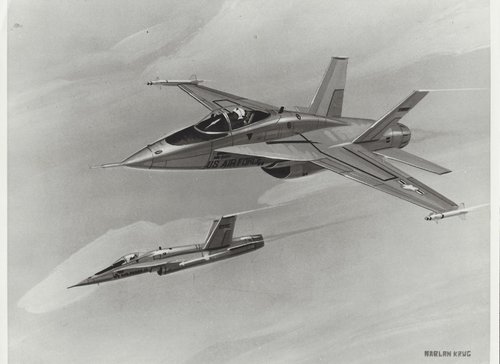
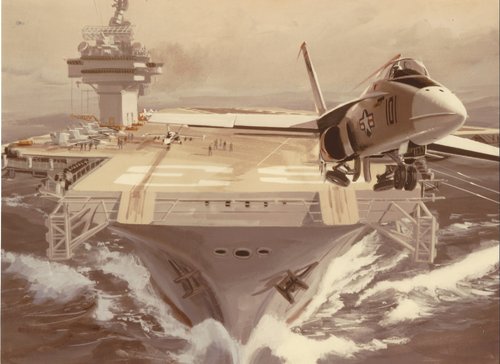
Last edited:
- Joined
- 27 December 2005
- Messages
- 17,752
- Reaction score
- 26,438
Thanks! The P.610 pic was in Tony Chong's Flying Wings and Radical Things in colour.
- Joined
- 1 November 2009
- Messages
- 638
- Reaction score
- 429
- Joined
- 3 June 2006
- Messages
- 3,094
- Reaction score
- 3,966
- Joined
- 3 June 2011
- Messages
- 18,340
- Reaction score
- 12,245
Oh, I like this photo montage as well of the YF-17 Demonstration Take-Off.
The F-18L would have been something. (But then we'd all be sitting around going, "man, that F-16 sure was sweet lookin'".
- Joined
- 29 January 2008
- Messages
- 916
- Reaction score
- 2,055

RARE Vintage Northrop IN-HOUSE YF-17 COBRA -EXPERIMENTAL PROTOTYPE Factory Model | eBay
This model represents the earliest P-530 concept version of the YF-17, in that the plaque just states "COBRA" (without the later YF-17 designation). Rarely seen, scarce Northrop COBRA emblem decals adorn both sides of the aircraft's nose.
www.ebay.com
Attachments
- Joined
- 27 December 2005
- Messages
- 17,752
- Reaction score
- 26,438
Similar threads
-
Boeing Lightweight fighter design to LWF requirement
- Started by overscan (PaulMM)
- Replies: 34
-
-
-
VFAX (1974) / NACF Projects (Pre F/A-18 concepts)
- Started by overscan (PaulMM)
- Replies: 53
-
McDD/Northrop/BAe ASTOVL/MRF/JAST/JSF studies
- Started by Antonio
- Replies: 255

